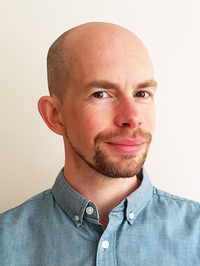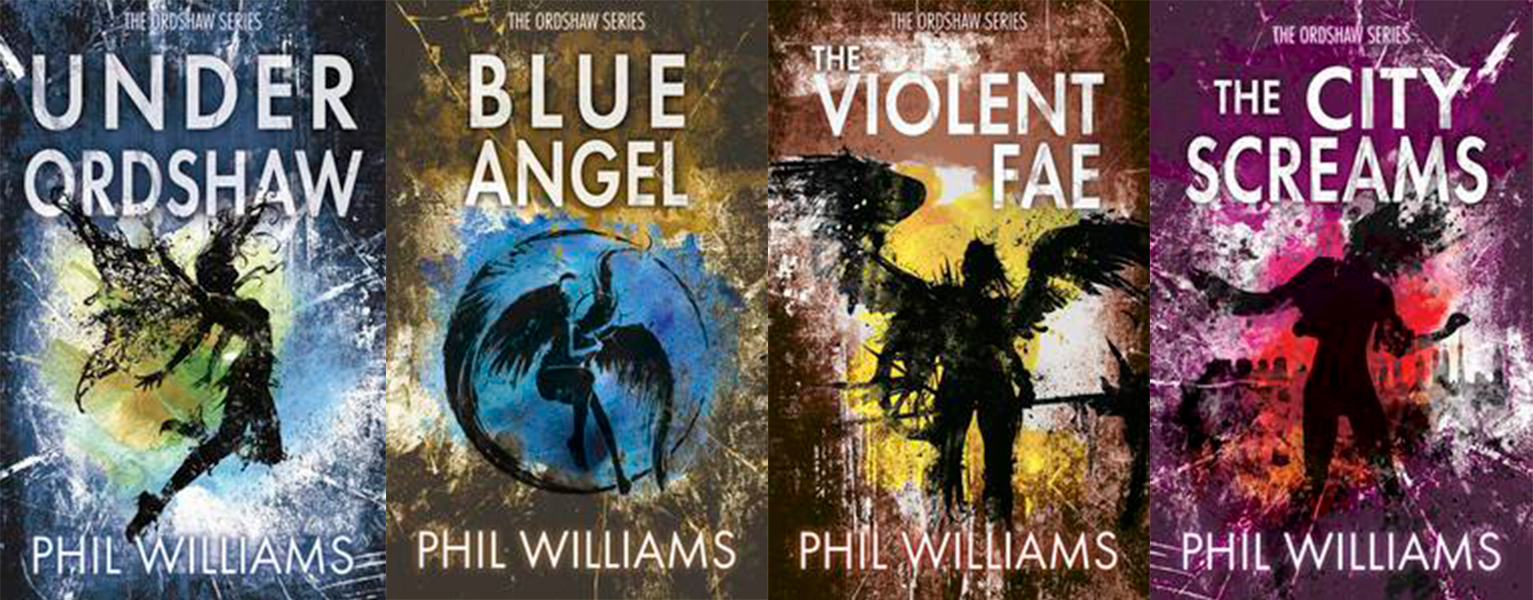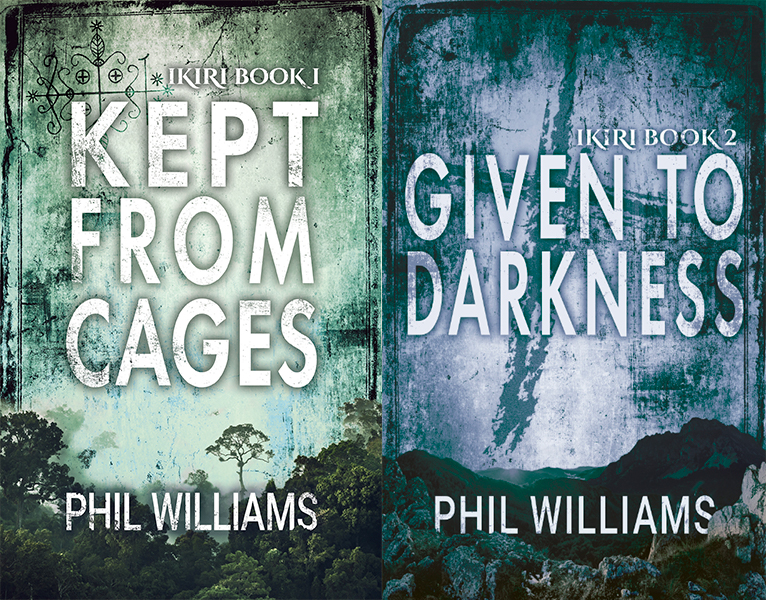March of the Sequels: Phil Williams
10 Mar 2023The Author/s

Phil Williams
Phil Williams writes contemporary fantasy and dystopian fiction and non-fiction grammar guides. His novels include the interconnected Ordshaw urban fantasy thrillers, the post-apocalyptic Estalia saga and the action-packed Faergrowe series. He also runs the website English Lessons Brighton, and writes reference books to help foreign learners master the nuances of English.
Phil lives with his wife by the coast in Sussex, UK, and now spends a great deal of time walking his impossibly fluffy dog, Herbert.
The Interview
First of all, tell me a little about your series and introduce us to the sequel(s).
Thanks for having me. Well, the Ordshaw series is a fairly widespread set of contemporary fantasy thrillers: there are various storylines sharing the same modern world with similar mysteries. It circles around the fictional UK city of Ordshaw, where strange things are going on, but also spreads internationally, with action taking place in Louisiana, the Congo, Tokyo and more. There are currently seven books in the series - four are entry points and three are direct sequels.
Blue Angel and The Violent Fae (Books 2 and 3) create a complete story following on from Under Ordshaw, which follows poker player Pax’s journey into a labyrinth under her city. She exposes conspiracies, mercenary fairies and various nasty monsters along the way. Blue Angel sees her on the run, trying to unravel the mysteries exposed in the first book, while The Violent Fae takes a wider scope that brings all the threads together in a frantic series of showdowns.
The other sequel in the mix is Given to Darkness, the second part of The Ikiri Duology (Books 5 and 6); this one directly follows on from Kept From Cages, to complete a tale of two halves. Kept From Cages is all converging elements as criminal jazz musicians, government agents and unhinged assassins circle in on each other over the mystery of a psychic child and a terrible secret in the Congo. The threads unite at the end of that book, and Given to Darkness is all about reaping what was sowed… It’s a fast-paced, twisty ride towards the story’s conclusion that wraps up a lot of what was laid out in the first book.


Do you find that most of your readers continue to read the whole series? Why do you think that is?
It’s a tough game in general, and with mine, the rate is probably a bit below average, which might be partly because readers come into Ordshaw at different points. It’s harder to keep things fresh and exciting by marketing sequels, because with new books you can keep going after new opportunities to reach more people, spreading your message by finding new places to do it; with sequels, you somewhat have to only go back to the places that already had an interest in the earlier book. It doesn’t really make sense to run adverts for later books, either, as unless you’ve got a huge readership it’s hard to target ads at existing readers.
How difficult is it to add new characters in a sequel into already established relationships?
I find this to be one of the most satisfying parts of writing sequels, as it’s always fun to explore how the existing dynamic can be upset, or sometimes even developed healthily, by putting in a fresh perspective. For instance, Blue Angel introduces Sam Ward as a main character, who’s very much a straight-edge, a big contrast after the first book lays out all sorts of unruly, nasty and otherwise unconventional characters. Come to think of it, the same thing happens when Sam Ward also turns up at the start of Given To Darkness!
Similarly, the character Lightgate who turns up in Blue Angel is calm and calculating in contrast to most of the others who are running around struggling just to get a grip on things. She was tremendous fun to work with, as she brings that contrasting lightness to her scenes, which gradually also delivers a new, softer kind of quiet menace.
Is it difficult to continue with worldbuilding for a world you have already built in book 1? Do you find it easier to switch locations for the sequel and start again with worldbuilding?
In some ways, it’s harder because you have to really keep track of things, from locations to the rules/histories you’ve established, but that’s just a question of organization (something I’m not necessarily great at, as the only true canon is the book itself and the planned details don’t always agree with the final product!). But that aside, I actually really enjoy building on previously established material, from adding new texture to existing bits of the world to expanding on minor details that might’ve appeared as throwaway comments earlier.
It’s long been the case with Ordshaw that I’ve been looking far ahead from the start, so I’m always excited to share more of this city and world that’s been growing in my mind for a long time. Almost every character that’s named in the series, no matter how small their mention, likely has a whole story to go with them already, and it’s a lot of fun to gradually develop an image of all the different neighbourhoods of the city. One particular Easter Egg I’ve got going is mention of a gangster called Jack the Tee who’s had his name dropped a bunch of times throughout the series. I know exactly who he is and if he ever finally appears it’s going to be nasty…
Switching locations is fun, too, though; the Ikiri Duology is a big leap from the other books, and gives it a different kind of texture.
Have you ever been stymied by a worldbuilding or plot detail from book 1 that is very inconvenient to deal with or write your way around in subsequent books?
Absolutely; The Violent Fae was a really hard book to write in some ways, because by that point there were two books already established and that meant a lot of constraints to work with. Probably the biggest concern there for me is characterisation; sometimes an overall arc or element of a satisfying later story would be much easier if the character had a slightly different background or personality traits. I can’t really think of a specific one right now though, probably blocked them all from my memory, it was a tough time!
Would you say your craft has improved with the subsequent books?
Definitely; it requires a lot of focus and honing to get a tight, satisfying sequel together, but it also gives you a lot of insight into what’s working well or not from the first book, as those elements have a direct impact on the later stages of the story.
Do you have all the timeline planned for the full series?
Not entirely, though I did for the two complete arcs; The Sunken City Trilogy and The Ikiri Duology do now contain complete stories, but they both feed into a much wider story. There are sequels to come to my books 4 and 5, as well as to follow on from those two stories, so I’ve got a lot to go with, when I can get around to it all. But I tend to break it down in chunks: I’ve got an idea for the next 2 or 3 books that should create another satisfying arc, which I’m still ironing out.
Do you have any marketing tips for sequels?
Keep hammering at marketing the first book, I guess. It becomes a numbers game then, the more sales Book 1 gets, the more likely you’ll get people reading the sequel. But that aside, I think the main tool for any indie author will always be a newsletter. If you keep your readers engaged through that, your own personal platform, they’ll be ready when the sequels come. In theory!
